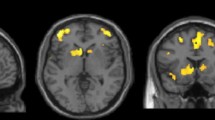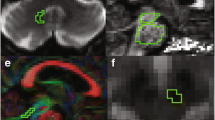Abstract
Introduction
The purpose of this research is to study white matter (WM) changes in patients of progressive supranuclear palsy (PSP) using automated analysis of diffusion tensor imaging (DTI) indices.
Methods
This was a prospective study comprising of 24 patients of PSP and 26 matched healthy controls. Fractional anisotropy, mean diffusivity (MD), axial diffusivity, and radial diffusivity (RD) changes were studied in the WM of the PSP patients using an automated analysis technique, tract-based spatial statistics (TBSS). Two subtypes of PSP, i.e., classic Richardson’s syndrome (PSP-RS) and parkinsonian type (PSP-P), were also compared among themselves to identify relative severity of WM changes as well as identify spatial distribution of the differences. Clinicoradiological correlation was done to determine the strength of correlation between WM abnormalities identified using TBSS and clinical scores.
Results
There were areas of significant abnormality seen in the frontoparietal cerebral WM, thalamus, midbrain tectum, superior cerebellar peduncle, and cerebellar WM. The abnormalities were more spatially widespread on MD and RD maps. Compared to PSP-P, the patients of PSP-RS had more spatial abnormalities localized to the frontal WM. There was no correlation between the observed WM changes and clinical rating scales.
Conclusions
The TBSS analysis showed widespread WM abnormalities in PSP patients including areas which have been shown to be involved in previous pathological studies. PSP-RS showed more severe white matter abnormality compared to the PSP-P subtype.



Similar content being viewed by others
References
Litvan I (2003) Update on epidemiological aspects of progressive supranuclear palsy. Mov Disord 18(Suppl 6):S43–S50
Carrilho PE, Barbosa ER (2002) Progressive supranuclear palsy in a sample of Brazilian population: clinical features of 16 patients. Arq Neuropsiquiatr 60(4):917–922
Nath U, Ben-Shlomo Y, Thomson RG, Lees AJ, Burn DJU (2003) Clinical features and natural history of progressive supranuclear palsy: a clinical cohort study. Neurology 60(6):910–916
Lubarsky M, Juncos JL (2008) Progressive supranuclear palsy: a current review. Neurologist 14:79–88
Morris HR, Wood NW, Lees AJ (1999) Progressive supranuclear palsy (Steele–Richardson–Olszewski disease). Postgrad Med J 75:579–584
Price S, Paviour D, Scahill R, Stevens J, Rossor M, Lees A, Fox N (2004) Voxel-based morphometry detects patterns of atrophy that help differentiate progressive supranuclear palsy and Parkinson’s disease. Neuroimage 23(2):663–669
Brenneis C, Seppi K, Schocke M, Benke T, Wenning GK, Poewe W (2004) Voxel based morphometry reveals a distinct pattern of frontal atrophy in progressive supranuclear palsy. J Neurol Neurosurg Psychiatry 75(2):246–249
Padovani A, Borroni B, Brambati SM, Agosti C, Broli M, Alonso R, Scifo P, Bellelli G, Alberici A, Gasparotti R, Perani D (2006) Diffusion tensor imaging and voxel based morphometry study in early progressive supranuclear palsy. J Neurol Neurosurg Psychiatry 77(4):457–463
Cordato NJ, Duggins AJ, Halliday GM, Morris JG, Pantelis C (2005) Clinical deficits correlate with regional cerebral atrophy in progressive supranuclear palsy. Brain 128:1259–1266
Agosta F, Kostić VS, Galantucci S, Mesaros S, Svetel M, Pagani E, Stefanova E, Filippi M (2010) The in vivo distribution of brain tissue loss in Richardson's syndrome and PSP—parkinsonism: a VBM-DARTEL study. Eur J Neurosci 32(4):640–647
Whitwell JL, Avula R, Master A, Vemuri P, Senjem ML, Jones DT, Jack CR Jr, Josephs KA (2011) Disrupted thalamocortical connectivity in PSP: a resting-state fMRI, DTI, and VBM study. Parkinsonism Relat Disord 17(8):599–605
Whitwell JL, Master AV, Avula R, Kantarci K, Eggers SD, Edmonson HA, Jack CR Jr, Josephs KA (2011) Clinical correlates of WM tract degeneration in progressive supranuclear palsy. Arch Neurol 68(6):753–760
Wang J, Wai Y, Lin WY, Ng S, Wang CH, Hsieh R, Hsieh C, Chen RS, Lu CS (2010) Microstructural changes in patients with progressive supranuclear palsy: a diffusion tensor imaging study. J Magn Reson Imaging 32(1):69–75
Kvickström P, Eriksson B, van Westen D, Lätt J, Elfgren C, Nilsson C (2011) Selective frontal neurodegeneration of the inferior fronto-occipital fasciculus in progressive supranuclear palsy (PSP) demonstrated by diffusion tensor tractography. BMC Neurol 11:13
Knake S, Belke M, Menzler K, Pilatus U, Eggert KM, Oertel WH, Stamelou M, Höglinger GU (2010) In vivo demonstration of microstructural brain pathology in progressive supranuclear palsy: a DTI study using TBSS. Mov Disord 25(9):1232–1238
Erbetta A, Mandelli ML, Savoiardo M, Grisoli M, Bizzi A, Soliveri P, Chiapparini L, Prioni S, Bruzzone MG, Girotti F (2009) Diffusion tensor imaging shows different topographic involvement of the thalamus in progressive supranuclear palsy and corticobasal degeneration. AJNR Am J Neuroradiol 30(8):1482–1487
Smith SM, Jenkinson M, Johansen-Berg H, Rueckert D, Nichols TE, Mackay CE, Watkins KE, Ciccarelli O, Cader MZ, Matthews PM, Behrens TE (2006) Tract-based spatial statistics: voxelwise analysis of multi-subject diffusion data. Neuroimage 31:1487–1505
Smith SM, Nichols TE (2009) Threshold-free cluster enhancement: addressing problems of smoothing, threshold dependence and localisation in cluster inference. Neuroimage 44:83–98
Jellinger KA (2008) Different tau pathology pattern in two clinical phenotypes of progressive supranuclear palsy. Neurodegener Dis 5:339–346
Morris HR, Gibb G, Katzenschlager R, Wood N, Hanger DP, Strand C, Lashley T, Daniel SE, Lees AJ, Anderton BH, Revesz T (2002) Pathological, clinical and genetic heterogeneity in progressive supranuclear palsy. Brain 125:969–975
Williams DR, de Silva R, Paviour DC, Pittman A, Watt HC, Kilford L, Holton JL, Revesz T, Lees AJ (2005) Characteristics of two distinct clinical phenotypes in pathologically proven progressive supranuclear palsy: Richardson’s syndrome and PSP—parkinsonism. Brain 128:1247–1258
Litvan I, Agid Y, Calne D, Campbell G, Dubois B, Duvoisin RC, Goetz CG, Golbe LI, Grafman J, Growdon JH, Hallett M, Jankovic J, Quinn NP, Tolosa E, Zee DS (1996) Clinical research criteria for the diagnosis of progressive supranuclear palsy (Steele–Richardson–Olszewski syndrome): report of the NINDS-SPSP international workshop. Neurology 47(1):1–9
Golbe LI, Ohman-Strickland PA (2007) A clinical rating scale for progressive supranuclear palsy. Brain 130:1552–1565
Hoehn MM, Yahr MD (1967) Parkinsonism: onset, progression and mortality. Neurology 17(5):427–442
Folstein MF, Folstein SE, McHugh PR (1975) “Mini-mental state”. A practical method for grading the cognitive state of patients for the clinician. J Psychiatr Res 12(3):189–198
Fahn S, Elton RL (1987) UPDRS Development Committee. Unified Parkinson’s Disease Rating Scale. In: Fahn S, Marsden CD, Calne DB, Goldstein M (eds) Recent developments in Parkinson’s disease. Macmillan, Florham Park, pp 153–163
Lancaster JL, Woldorff MG, Parsons LM, Liotti M, Freitas CS, Rainey L, Kochunov PV, Nickerson D, Mikiten SA, Fox PT (2000) Automated Talairach atlas labels for functional brain mapping. Hum Brain Mapp 10(3):120–131
Smith SM, Zhang Y, Jenkinson M, Chen J, Matthews PM, Federico A, De Stefano N (2002) Accurate, robust and automated longitudinal and cross-sectional brain change analysis. Neuroimage 17(1):479–489
Smith SM, Jenkinson M, Woolrich MW, Beckmann CF, Behrens TEJ, Johansen-Berg H, Bannister PR, De Luca M, Drobnjak I, Flitney DE, Niazy R, Saunders J, Vickers J, Zhang Y, De Stefano N, Brady JM, Matthews PM (2004) Advances in functional and structural MR image analysis and implementation as FSL. Neuroimage 23(S1):208–219
Acosta-Cabronero J, Williams GB, Pengas G, Nestor PJ (2010) Absolute diffusivities define the landscape of WM degeneration in Alzheimer’s disease. Brain 133(Pt 2):529–539
Beaulieu C (2002) The basis of anisotropic water diffusion in the nervous system—a technical review. NMR Biomed 15(7–8):435–455
Della Nave R, Ginestroni A, Diciotti S, Salvatore E, Soricelli A, Mascalchi M (2011) AD is increased in the degenerating superior cerebellar peduncles of Friedreich’s ataxia. Neuroradiology 53(5):367–372
Weaver KE, Richards TL, Liang O, Laurino MY, Samii A, Aylward EH (2009) Longitudinal diffusion tensor imaging in Huntington’s disease. Exp Neurol 216(2):525–529
Williams DR, Holton JL, Strand C, Pittman A, de Silva R, Lees AJ, Revesz T (2007) Pathological tau burden and distribution distinguishes progressive supranuclear palsy—parkinsonism from Richardson’s syndrome. Brain 130:1566–1576
Litvan I, Hauw JJ, Bartko JJ, Lantos PL, Daniel SE, Horoupian DS (1996) Validity and reliability of the preliminary NINDS neuropathologic criteria for progressive supranuclear palsy and related disorders. J Neuropathol Exp Neurol 55:97–105
Dickson DW (1999) Neuropathologic differentiation of progressive supranuclear palsy and corticobasal degeneration. J Neurol 246(Suppl 2):II6–II15
Goedert M (2005) Tau gene mutations and their effects. Mov Disord 20(Suppl 12):S45–S52
Zhukareva V, Joyce S, Schuck T, Van Deerlin V, Hurtig H, Albin R, Gilman S, Chin S, Miller B, Trojanowski JQ, Lee VM (2006) Unexpected abundance of pathological tau in progressive supranuclear palsy WM. Ann Neurol 60(3):335–345
Warmuth-Metz M, Naumann M, Csoti I, Solymosi L (2001) Measurement of the midbrain diameter on routine magnetic resonance imaging: a simple and accurate method of differentiating between Parkinson disease and progressive supranuclear palsy. Arch Neurol 58(7):1076–1079
Cosottini M, Ceravolo R, Faggioni L, Lazzarotti G, Michelassi MC, Bonuccelli U, Murri L, Bartolozzi C (2007) Assessment of midbrain atrophy in patients with progressive supranuclear palsy with routine magnetic resonance imaging. Acta Neurol Scand 116(1):37–42
Halliday GM, Macdonald V, Henderson JM (2005) A comparison of degeneration in motor thalamus and cortex between progressive supranuclear palsy and Parkinson’s disease. Brain 128:2272–2280
Cordato NJ, Pantelis C, Halliday GM, Velakoulis D, Wood SJ, Stuart GW, Currie J, Soo M, Olivieri G, Broe GA, Morris JG (2002) Frontal atrophy correlates with behavioural changes in progressive supranuclear palsy. Brain 125(Pt 4):789–800
Litvan I (2004) Update on progressive supranuclear palsy. Curr Neurol Neurosci Rep 4:296–302
Kier EL, Staib LH, Davis LM, Bronen RA (2004) MR imaging of the temporal stem: anatomic dissection tractography of the uncinate fasciculus, inferior occipitofrontal fasciculus, and Meyer’s loop of the optic radiation. AJNR Am J Neuroradiol 25(5):677–691
Armstrong RA, Lantos PL, Cairns NJ (2009) Hippocampal pathology in progressive supranuclear palsy (PSP): a quantitative study of 8 cases. Clin Neuropathol 28(1):46–53
Cummings JL (1993) Frontal-subcortical circuits in human behavior. Arch Neurol 50:873–880
Henderson JM, Carpenter K, Cartwright H, Halliday GM (2000) Loss of thalamic intralaminar nulei in progressive supranuclear palsy and Parkinsons disease: clinical and therapeutic implications. Brain 123:1410–1421
Rizzo G, Martinelli P, Manners D, Scaglione C, Tonon C, Cortelli P, Malucelli E, Capellari S, Testa C, Parchi P, Montagna P, Barbiroli B, Lodi R (2008) Diffusion-weighted brain imaging study of patients with clinical diagnosis of corticobasal degeneration, progressive supranuclear palsy and Parkinson’s disease. Brain 131:2690–2700
Schofield EC, Hodges JR, Macdonald V, Cordato NJ, Kril JJ, Halliday GM (2010) Cortical atrophy differentiates Richardson's syndrome from the parkinsonian form of progressive supranuclear palsy. Mov Disord. Dec 13. doi:10.1002/mds.23295
Acknowledgments
BSB acknowledges Indian Council for Medical Research for PhD financial support.
Conflict of interest
We declare that we have no conflict of interest.
Author information
Authors and Affiliations
Corresponding author
Rights and permissions
About this article
Cite this article
Saini, J., Bagepally, B.S., Sandhya, M. et al. In vivo evaluation of white matter pathology in patients of progressive supranuclear palsy using TBSS. Neuroradiology 54, 771–780 (2012). https://doi.org/10.1007/s00234-011-0983-7
Received:
Accepted:
Published:
Issue Date:
DOI: https://doi.org/10.1007/s00234-011-0983-7




